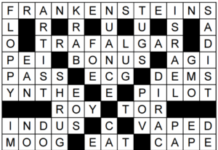The Kitchener-Waterloo Art Gallery’s newest exhibition, <em>Imitation of Life</em>, celebrates new and hybrid media as a means of exploring human experience. </p>
A diverse assortment of media and subject matter from a range of contemporary artists, the show features works by Lois Andison, Daniel Barrow, Kota Ezawa, Adad Hannah, Faith La Rocque, Lorna Mills, Jonathan Schipper, Allison Schulnik, and Skawennati.
The first pieces the viewer is confronted with when entering the gallery immediately differentiate the contents of the show from more conventional artistic practices. Faith La Rocque’s Imitation of Life (Liquid Trust) is a unique intervention wherein synthesized oxytocin is routinely released into the gallery through the building’s ventilation system. Much like the placebo effect, La Rocque’s installation plays on expectations and the degree of confidence the viewer places in modern medicine. Her second piece, Imitation of Life (Mimosa Pudica), is a living plant placed under a vivid violet light. The species is known for curling and withdrawing from physical touch, and produces a low-level toxin that immobilizes any larvae that might threaten the plant.
“For this exhibition there are artists who are working with new media and there are also artists who work with arguably obsolescent technology as well. Daniel Barrow is a good example of that — his work is heavily influenced by the tradition of magic lantern shows and early Victorian amusements that are essentially precursors to cinema,” said Crystal Mowry, the gallery’s curator of exhibitions and collections.
Barrow’s work, The Thief of Mirrors, uses new and outdated technology to create a larger narrative that is impressive in its sheer scale. Made up of roughly a dozen projections (overhead, LCD, TV) with some images filtered through water, the resulting work is as immersive as it is theatrical.
“Old things are still in the world. In some sense the technology may not be widely in use but if it still works it has the potential to interest or charm people who encounter it or people who are discovering it for the first time….These things are coexisting and have a shared history, and artists are choosing to work with them depending on what they want to emphasize in the content of their work,” said Mowry.
Photography and sculpture are also seen within the exhibition, albeit subverted from their traditional counterparts. Jonathan Schipper’s The Inherent Beauty In A Failure to Reconstruct, is a kinetic sculpture with long, mechanical appendages attached to the fragments of a shattered teacup. As the title implies, these appendages attempt to repair the pieces as a perpetual exercise in futility. Similarly, UW associate professor Lois Andison’s need is a subtle kinetic sculpture made with the same material as tombstones, reducing a lifetime of sensory information into the phrases “Feed me, Seed me, Need me, Weed me,” which is at once humorous and profound.
Animation sees significant representation in Imitation of Life. Allison Schulnik’s Eager highlights stop-motion animation, using clay humanoid forms that transform constantly and dance in a way that is at times unsettling. The film is mesmerizing in its use of both colour and violence; eerie characters lit in rainbow hues slash each other open and wear the leftover skin.
Meanwhile, Lorna Mills’s Peaceable Kingdom draws inspiration from both Naim June Paik’s iconic installations of sprawling television sets as well as snippets of memes that endlessly circulate the Internet. Set across seven screens, the energetic displays flash with a medley of gifs such as pixellated fighter jets and Vladimir Putin cuddling with dogs. The installation grapples with the nature of authorship and appears to be politically charged; though much like the Internet itself, its precise message is eclipsed by the hilarity of the medium.
Conversely, Skawennati’s Time TravellerTM, an episodic animation with an astounding runtime of 75 minutes, brings a unique aboriginal perspective to contemporary virtual spaces. Using the virtual world of Second Life, a now outdated platform, Skawenatti’s work constructs narratives that deal largely with community, history, and colonialization.
“Technology moves so fast. Back in 2003, Second Life was a very exciting, very dynamic thing. In the time that’s passed since then, that space has largely fallen out of favour because the people who typically might have used it are the people who are using social media. As a precursor to social media, it was this dynamic space to share, have social interactions, and to meet people…. She’s using this space that has in essence become a virtual ghost town,” said Mowry.
“I think we are often looking for ways to express aspects of our personality, our identity, and sometimes just living that is not really enough. Sometimes that manifests in analogies and metaphors that take the form of physical things in a space. I like to think that the works we see are extensions of the artists that make them…. In some respect they’re an extension of the things that preoccupy them, or the thoughts that they’re grappling with in terms of understanding what it means to be alive in this world.”
Imitation of Life is open at the Kitchener-Waterloo Art Gallery until Jan. 10, 2016.































